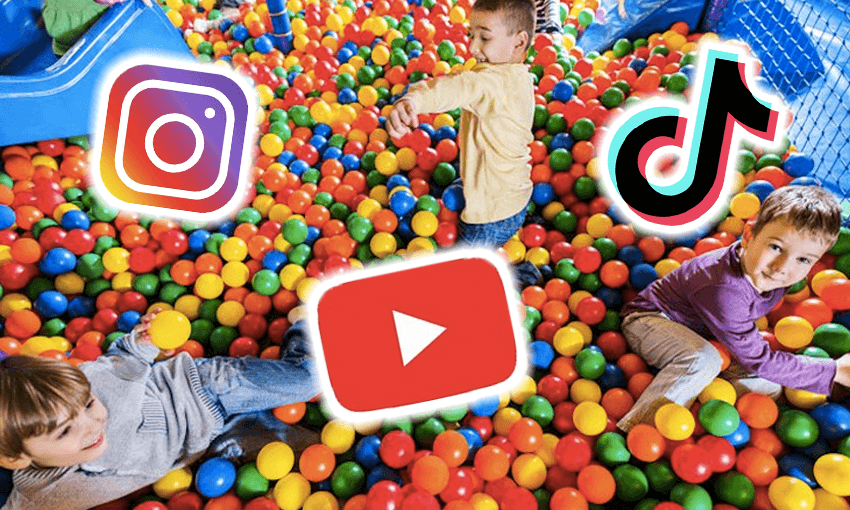An Auckland dad is offering good money to someone who can teach his daughter the basics of being a YouTuber. Vlogging has boomed in popularity among young people in recent years as a potential career path, but how achievable is it, and is it safe?
Sandeep Khurana is a busy dad. He works in real estate and that often means long hours and not much time at home to spend with his 10-year-old daughter. She’s always been a fan of YouTube videos, watching channels like Norris Nuts Do Stuff and Georgia Productions, both featuring young female presenters who complete challenges, play games and test toys and products for their millions of subscribers.
Last year when Khurana noticed her starting to take an interest in creating her own videos, he thought it was the perfect opportunity to help her creativity flourish. Now he’s on the hunt for a director/producer for his daughter’s own YouTube channel. He’s promising good money and the use of a “green screen studio, camera, lighting, and sound equipment” to make her into a star.
“What I’m really hoping is to get her from being glued to the screen to actually creating what’s behind the screen. It gets her off her bum and starts her thinking outside of the box, making stories and creating.”
Most American-based social media outlets require people to be 13 years or older to sign up, but that doesn’t mean there are much younger kids with profiles. Apps like TikTok and Instagram are filled with kids as young as eight posting photos and videos. Netsafe acting CEO Sean Lyons says the internet isn’t necessarily a bad place for children, but parents need to make sure they’re aware of what apps their kids are using.
“If your kid is on TikTok then you need to put TikTok on your phone, you need to spend some time becoming familiar with what it is… Spend some time with your young people and explore the app and get them to talk about what they do. It’s a great way to build that trust and get a better understanding of what and how they do things.”
A recent study from the US, UK and China showed children were three times more likely to want to become a YouTuber than an astronaut. It’s a career that’s growing in popularity, with big money, fame and non-traditional work hours promised to those who make it. For kids who have grown up watching other children review toys and do fun challenges, it looks like a great alternative to their parent’s 9-5.
Khurana doesn’t mind if it doesn’t turn into a career for his daughter. He wants her to explore her passion for creating content, but says there’s no pressure if she realises it’s not what she wants to do. For him, the exercise is more about encouraging her to create, not just watch other people.
“Since 2019 I’ve seen her turn on the camera and cook, flipping the camera and doing TikTok dances… If in six months it becomes apparent that she doesn’t have the natural flair then that’s fine, but if she really starts to blossom and flourish then it could become a career.”
But as with any online presence, there is a dark side to being a child on YouTube. In 2016 David Farrier wrote on The Spinoff about a sinister side of the platform where sexual predators were making children upload fetish videos under the guise of “YouTube challenges”.
Lyons says predatory behaviour is an issue that Netsafe and all social platforms are constantly trying to remedy, and there is still work to be done. YouTube made a change to their site in early 2019, banning the comments sections on all videos containing children. This was a step to tackle predatory behaviour occurring there.
“There are risks around contact and there are risks around content. Generically that means if somebody puts themselves in a contactable space online then there are dangers around those that might contact that individual,” explains Lyons.
“You could say that about a phone, about email, about video sharing platforms. There are cases where people might use those services to contact somebody and they may not have particularly nice intentions in that context. There are myriad potential risks and challenges but we have to keep in mind that the numbers of individuals who use these services, the majority of interactions using these platforms are positive.”
The highest paid YouTuber of 2019 was 8-year-old Ryan Kaji. Known for his toy review videos, Kaji has topped the list of highest paid YouTubers for two years now, last year raking in US$26m through sponsorships and advertising on his channel, Ryan’s World.
But that’s not the case for the majority of people who start a YouTube channel. As of 2019 there were more than 31 million channels on the platform, and only a fraction of these make any sort of money from it.
Careers NZ doesn’t even have a listing for any sort of social media influencer or vlogger on their site. They told The Spinoff that was because they like to focus on careers that require qualifications or specialty training.
Just like when their parents were growing up with dreams of Hollywood fame, a significant portion of today’s young people are growing up with the bright blue lights of the internet in their vision. It’s no wonder young people want to become YouTube stars, because perhaps for the first time they’re seeing celebrities who walk, talk and look just like them.

